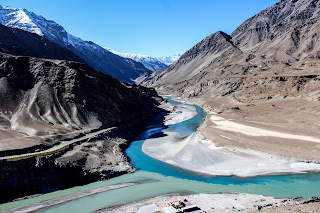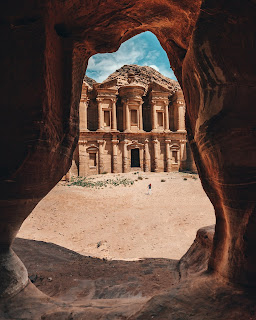10 important facts about Indus valley Civilization:
The Indus Valley Civilisation existed during the Bronze Age in South Asia extending from today's Afghanistan to Pakistan and northwest part of India.
It lasted for about 1,600 years and mysteriously collapsed it was one of the three early civilizations of the ancient world the other two being the ancient Egypt.
It was also the largest of all the three and just like any other civilization. it flourished in the basins of a river system, which was the Indus River during the period of its existence the Indus Valley Civilisation managed to give birth to numerous incidents that remain interesting to date the fact about the masterpiece architecture town planning uniformity in measuring weights systemic drainage systems and its decline is some of the most exciting aspects of this civilization which clearly showed that they were ahead of their time with every single discovery made about it a new factor that comes out never fails to interest humans.
I am presenting 10 surprising facts that you might not know about the Indus Valley Civilisation.
# NO -10
the Indus Valley Civilisation may have been the first civilization to use wheeled transport. the Indus civilization economy appears to have depended significantly on trade which was facilitated by major advances in transport technology.
These advances might have included Bullock trucks that are indistinguishable from those seen all through South Asia today just as boats.
A portion of these boats were likely little level lined specialty maybe determined by sail like those one can see on the Indus Waterway today.
In any case, archeologists have found an enormous dug pet hotel that they view as a docking office at the waterfront city of Lahore in West in India and alongside that broad channel network utilized for water system has likewise
# NO-9
there were cities with masterpiece engineering and standardized planning the Indus Valley Civilisation had amazing and mesmerizing structures particularly into Harappa and mohenjo-daro baked bricks were used in building construction and the buildings were built oriented towards the wind direction to provide natural air conditioning and the private Wells and sanitation system have even been found with hydraulic engineering in practice town planning was a unique feature of the Indus Valley Civilisation and towns were laid down in a rectangular pattern.majority of the houses were double floore and wide.
There were well-built granaries Seattle's burial grounds and baiting platforms as well.
But for a civilization thriving in the banks of a river disturbance by flooding is inevitable floods were caused by the shift of the Indus River which greatly affected the settlement areas and evidences have even shown that standardized planning and designs may have been done to aid the reconstruction of the cities that relocated owing to the destruction by floods.
# NO-8
they had highly skilled craftsmen the Indus people had used the best engineering skills and they experts in Engineering and handicrafts.
They used the modern metallurgy techniques to extract metals like copper bronze in an LED.
They even made different sculptures Potteries gold jewelleries, and anatomically detailed figures and they used to wear necklaces and bangles out of all creations the statue of a girl made of bronze is considered to be the most known craft work of them.
The statue is named as the dancing girl of mohenjo-daro which is in a standing position with her left armed concealed with bangles apart from this the valley also made a name for various handicraft works including shield carving pottery and stamps making.
#NO-7
You may think of dentistry to be a quite modern medical practice, but it's pretty old.
In fact, it's probably more than 7,000 years old people of the Indus Valley Civilisation practiced it in early Harappan period and in 2006 archaeologists finally confirmed the earliest known evidence of drilling a living person, teeth 11 drilled molar crowns from nine different adults were discovered in neolithic graveyard that are believed to be seven thousands to nine thousands years old.
#NO-6
they used astonishing shields as identifier x' indus people used to trade with Mesopotamians and the egyptians, but the most interesting thing that they produced were seals that they used as identification markers on some things and mudd's balls.
These seals contain a written language that we still cannot read and a lot of interesting designs of fantastical creatures animals and people probably gods but the most famous and profound shield is the one called the Pashupati shield in the shield a three-headed man with buffalo horns and his middle head is sitting between a tiger and a bull the exact meaning of the image isn't well understood, but it's proposed to be the earliest depiction of the Hindu god Shiva was also regarded as the lord of the animals.
#NO-5
the Indus people had developed a very precise measuring techniques.
The Indus Valley Civilization is famous for its inventions and discoveries such as the step well button measuring weights and rulers the oldest and the most precise ancient ruler was developed in the Indus Valley Civilisation and it was first known as the measuring rod and was made out of a copper alloy bar.
The initial measurement of this ruler was done in a perfectly divisible format where the hold of the ruler was divided into uniform units corresponding to three point five five millimeters and marked in an accurate the Simone subdivision.
The researchers during those days were able to make precise measurement over the length weight and time.
They were the first one to have measurement scheme to measure time and object.
They were also able to measure the length in small decimal figures.
#NO-4
We have evolution of one of the most famous structure the great bath one of the oldest and most famous baths in history.
The great bath was a structure designed in the Indus Valley civilization.It is also known as the public water tank in history.
The great bath was definitely the most skilled work holding high religious and social values and it was structured in a stepwell format with stairs leading down towards the well, it is located in mohenjo-daro in Pakistan holding the dimensions of eleven point eight eight meters by seven point zero one meter and the total depth of about two point four three meters.
The bricks used to build a bath are of uniform size and shape with Gibson plastered edges making them waterproof and long-lasting.
#NO-3
We have earliest discoveries confused the city to be children's City.
The earliest discovery of the Indus Valley Civilization was done since 1921 and Harappan on GEB region and went on to Mohenjo-Daro in 1922.
The discovery was near the Indus River in Sindh region during the excavation of the valley various ruins were discovered which included different kinds of metals seals stamps pottery and scripts.
However, the discovery of the ruins belonging to the younger aged group outnumbered there are other ruins the discovery included numerous toys and kids friendly staff which led the archeologists and researchers into a confusion as a result.
They came to the assumption that the inhabitants of this civilization were mostly children.
Okay time for another quick short break.
So what do you think about the Indus Valley Civilisation?
Do you think it was better than the Egyptian civilization and the Mesopotamian civilization do write those down in the comment sections below ok, moving into the topic we have in no 2
# No-2
the development of the oldest script which remains undecided till date the Indus Valley Civilisation discovered the oldest script in history.
It is famously known as the Indus script or the Harappan script and belongs to the Munda family.
The script was first discovered between the years 3500 and 1900 BCE and contains about 400 signs the signs and symbols were mostly found written on most exotic places such as on seals pottery and stamps rather than just on paper despite being the earliest script discovered.
The writing is taken as the mysterious language which remains undeciphered to date the primary reason behind the decoding is an availability of the underlying literature and bilingual inscriptions.
Finally in number one.
# NO-1
We have the declination of the indus valley civilization shortly after the declination of the significant cities like Harappa and mohenjo-daro the Indus Valley Civilization also declined and it was during the 1500 BCE.
There is still confusion and mixture of reason behind the declination of the oldest civilization and some researchers believe the reason to be natural disasters like flood an earthquake.
Whereas some consider it to be massive migration of the Aryans.
However, the most reliable reason behind it is believed to be the change in climate that brought the Indus River to dry during the early 1900 BCE after the collapse of civilization numerous ruins were discovered during its excavation out of which many ruins created history and helped to create a memoir of the existence of the oldest civilization.
Well since the time of its discovery, the Indus Valley Civilization went through numerous exciting incidents and moments that are hard to.























0 Comments